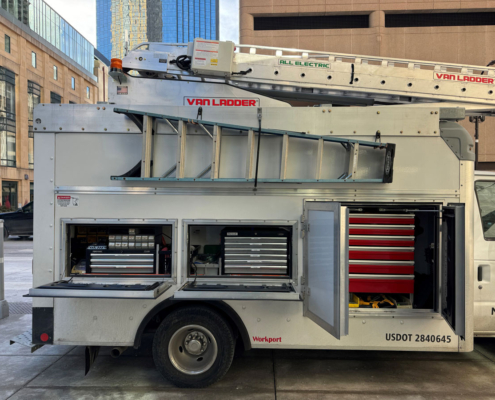A Traveling Warehouse

The next best option for a chassis was Ford’s E450 or Chevy’s 4500. Of course, these are both chassis cabs, not complete vehicles. They are shipped to an upfitter to receive a camper, or a box, or a service body. So we began exploring various upfitters to find a box that would pair well with a Van Ladder.
The big downside of changing vehicle types was the cost. How much would our price tag increase? Our customers were used to a certain price point, and we feared their reaction to a substantial hike. But our predicament wasn’t all negative. Moving to a heavier chassis would allow our customers to double their onboard payload for tools and inventory from 1,800 lbs. to 3,700 lbs. The heavier chassis also had dual rear wheels, giving the vehicle more stability, both on the road and when the aerial lift was in use. Would these benefits justify a significant price increase? The answer to that question would depend upon the box we chose. We needed to find a box with game-changing improvements over a traditional cargo van.
Then we discovered Rockport Commercial Vehicles. Rockport manufactures a couple of chassis cab bodies perfectly suited for sign and lighting work. The most popular is the Workport model. The Workport has a spacious enclosed area measuring 146” long by 50” wide. Sign companies use this space for hauling signs. It protects their product from road grime, flying objects, rain, snow, and vandalism. Having this storage area saves time at the shop because signs don’t require meticulous packaging when traveling indoors. It also saves time at the install site because the signs don’t need cleaning once they arrive.
Another equally enticing feature of the Workport box is the six outside compartments that lock with a single key fob. These compartments allow installers and service technicians to keep things organized. One compartment can be dedicated to fasteners, while another contains electrical components. There can be separate compartments for hand tools, power tools, cleaning supplies, and specialty vinyl tools. The key is knowing where things are and having them within easy reach. The old cargo vans didn’t have separate storage compartments, so they tended to be like your junk drawer in the kitchen—packed full of important items that are difficult to find without rummaging through EVERYTHING. How much time does it save to know where everything is? How much frustration can be avoided? I think most people would agree that proper organization is a big factor in both efficiency and job satisfaction.
About two years ago, I learned something about the Workport box that I didn’t fully comprehend before that. I was interviewing a customer (CMI Signs in Safford, AZ) and one of their installers was comparing their old way of prepping for installations with their new way of prepping. Here’s what he said: “Before, we spent the first two hours of the day prepping, getting stuff ready, packing up, going through our checklist twice, three times, just to make sure we had everything. Now, it’s like, we just pack the signs up and go. It saves us time, lots of time.”
Here’s the profound thing I finally understood: If your truck doesn’t have enough onboard storage space to stock EVERYTHING needed for ANY type of installation, you’ll be forever shackled to a checklist (Or forever leaving the jobsite to run for parts). But if you have the necessary storage space to keep all your fasteners onboard, all your electrical components, all your hand tools, all your power tools, everything needed for any installation, then you won’t need a checklist because it’s already in the truck. In CMI’s case, having the Workport box instead of their old service body saved about ten hours per week. Now, every morning they just throw the signs in the truck and go to work. Sure, they occasionally need to check their onboard inventory of fasteners, etc., but that doesn’t take more than a couple of hours a month.
The other huge advantage the Workport box offers when paired with the frond-end of a van is that it fits into a single parking stall. That’s a big achievement for a truck with 500 cubic feet of storage! Think of the perpendicular parking in front of most strip malls. If you have a long vehicle you’re probably coning off five of those parking spots the night before an installation. That’s time-consuming. Plus, it tests the patience of the other shop owners, who lose those parking places for their customers. It’s nice to pull into one stall, throw up a sign, and get to the next job.
Does the Workport service body offer game-changing improvements over a cargo van? When we’ve asked the customers who’ve owned both, their answer is a resounding YES. Having an enclosed area for signage, with plenty of organized storage space for tools and inventory, in a truck that fits into a single parking stall, brings a surprising pile of money to the bottom line. It’s funny how an existential crisis can become a huge blessing.


